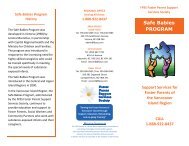Trauma Informed Care Resources - Foster Parents Support Services ...
Trauma Informed Care Resources - Foster Parents Support Services ...
Trauma Informed Care Resources - Foster Parents Support Services ...
You also want an ePaper? Increase the reach of your titles
YUMPU automatically turns print PDFs into web optimized ePapers that Google loves.
<strong>Trauma</strong> <strong>Informed</strong> <strong>Care</strong><strong>Resources</strong>Compiled by Kathy Baird, <strong>Foster</strong> Parent
1. Child <strong>Trauma</strong> Academyhttp://www.childtrauma.org under Articles there is a lot of great information.CTA University http://www.childtrauma.org/index.php/training/cta-universityThe CTA online university offers free online courses for interested participants.Currently we have four self-directed online courses:The Amazing Human Brain and Human Development:http://www.childtraumaacademy.com/amazing_brain/index.htmlSurviving Childhood: An Introduction to the Impact of <strong>Trauma</strong>:http://www.childtraumaacademy.com/surviving_childhood/index.htmlThe Cost of Caring: Secondary <strong>Trauma</strong>tic Stress and the Impact of Working with High-Risk Children andFamilies: http://www.childtraumaacademy.com/cost_of_caring/index.htmlBonding and Attachment in Maltreated Children:http://www.childtraumaacademy.com/bonding_attachment/index.html2. Keep the Cool in School ArticlesKeep the Cool in School: http://teacher.scholastic.com/professional/bruceperry/cool.htmIn the first of a series of articles about promoting nonviolent behavior in children, Dr. Perry gives an overviewof the 6 core strengths that children need in order to be humane.Attachment: The First Core Strength: http://teacher.scholastic.com/professional/bruceperry/attachment.htmIn the second article of the Keep the Cool in School campaign, Dr. Perry discusses attachment and how itcontributes to preventing aggression and anti-social behaviors in children.Self-Regulation: The Second Core Strength:http://teacher.scholastic.com/professional/bruceperry/self_regulation.htmIn the third article of the Keep the Cool in School campaign, Dr. Perry explores self-regulation and how itcontributes to preventing aggression and anti-social behaviors in children.Affiliation: The Third Core Strength: http://teacher.scholastic.com/professional/bruceperry/affiliation.htmIn the fourth article of the Keep the Cool in School campaign, Dr. Perry shares how educators can help studentsfeel included, connected and valued.Awareness: The Fourth Core Strength:http://teacher.scholastic.com/professional/bruceperry/different_same.htmIn the fifth article of the Keep the Cool in School campaign, Dr. Perry shares ideas about encouraging childrento respect and appreciate each other's differences and similarities.Tolerance: The Fifth Core Strength: http://teacher.scholastic.com/professional/bruceperry/tolerance.htmIn the sixth article of the Keep the Cool in School campaign, Dr. Perry discusses tolerance, the most complex ofthe six core strengths.Respect: The Sixth Core Strength: http://teacher.scholastic.com/professional/bruceperry/respect.htmIn the seventh article of the Keep the Cool in School campaign, Dr. Perry explores how educators can helpstudents accept and enjoy the differences in others.
3. The Developing ChildA Place for Everyone: Nurturing Each Child's Niche:http://teacher.scholastic.com/professional/bruceperry/niche.htmOne of the many jobs of early childhood educators is to nurture the uniqueness of every child. This articleincludes tips for identifying a child's individual strengths and needs.The Importance of Pleasure in Play: http://teacher.scholastic.com/professional/bruceperry/pleasure.htmPlay, more than any other activity, fuels healthy development of children. In this article, learn strategies formixing emotional, social, and cognitive challenge with fun.Curiosity: The Fuel of Development: http://teacher.scholastic.com/professional/bruceperry/curiosity.htmFor children, the positive cycle of learning is fueled by curiosity, and the pleasure that comes from discoveryand mastery. Find out how teachers can help to keep the process going.How Sounds Become Words:http://teacher.scholastic.com/professional/bruceperry/soundsbecomewords.htmHow is it that words come to have meaning? When does the sound become the word? And how can we helpchildren learn the true meaning of our most important words?The Developmental Hot Zone: http://teacher.scholastic.com/professional/bruceperry/hot_zone.htmHelping children move from the comfortable and familiar, and take on new challenges, is a very important task.In this latest article, Dr. Perry outlines strategies for providing the right opportunities for children at the righttime, and in the proper sequence.The Meaning in Words: http://teacher.scholastic.com/professional/bruceperry/words.htmIn a conversation with Early Childhood Today editor Helen Benham, Dr. Perry explains how children learn tomake sense of the language they hear — in conjunction with the actions they see.Biological Relativity: Time and the Developing Child:http://teacher.scholastic.com/professional/bruceperry/biological_relativity.htmCan mere hours in infancy have more power to shape us than months in middle age?4. Children in DistressChildren and Loss: http://teacher.scholastic.com/professional/bruceperry/childrenloss.htmTeachers serve as a crucial emotional bridge for a child at times of loss. What do we need to know to helpstudents cope, especially in the classroom environment?Death and Loss: Helping Children Manage Their Grief:http://teacher.scholastic.com/professional/bruceperry/death_and_loss.htmDr. Perry shares strategies for helping children to adjust to difficult situations such as moving, divorce, anddeath.Bonding and Attachment in Maltreated Children: Consequences of Emotional Neglect in Childhood:http://teacher.scholastic.com/professional/bruceperry/bonding.htmDr. Perry explains why experiences during infancy and early childhood are so critical to shaping our capacity toform emotionally healthy relationships, and how maltreatment can impair this important capability.
Bonding and Attachment in Maltreated Children: How You Can Help:http://teacher.scholastic.com/professional/bruceperry/bonding_help.htmIn this article, Dr. Perry suggests ways that responsive adults, such as parents, teachers, and other caregivers,can make all the difference in the lives of maltreated children.Why Does Violence Happen? http://teacher.scholastic.com/professional/bruceperry/why_violence.htmDr. Perry revisits the Columbine High School tragedy one year later. Use this article as a teaching resource toinitiate student discussion.The Child's Loss: Death, Grief, and Mourning:http://teacher.scholastic.com/professional/bruceperry/child_loss.htmFind out how teachers, caregivers, and other adults can help children exposed to traumatic death.The Impact of Abuse and Neglect on the Developing Brain:http://teacher.scholastic.com/professional/bruceperry/abuse_neglect.htmFind out how destructive experiences can affect children in far-reaching ways — emotional, behavioral,academic, social, and physical — for life.Principles of Working With <strong>Trauma</strong>tized Children:http://teacher.scholastic.com/professional/bruceperry/working_children.htmSome special considerations for teachers and caregivers in understanding and working with children who havesuffered trauma.Aggression and Violence: The Neurobiology of Experience:http://teacher.scholastic.com/professional/bruceperry/aggression_violence.htmOver 5 million children are directly exposed to violence in the U.S. each year. What will the impact on oursociety be? Read on to find5. The Brain and LearningAttunement: Reading the Rhythms of the Child:http://teacher.scholastic.com/professional/bruceperry/attunement.htmLearning about children's individual strengths, vulnerabilities, and preferred styles of communication can helpteachers to reach and teach each child more effectively.Using Technology in the Early Childhood Classroom:http://teacher.scholastic.com/professional/bruceperry/using_technology.htmIn this article, Dr. Perry outlines how computers, the Internet, television, and other technology tools can helpchildren develop curiosity, problem-solving, and independent-thinking skills.Creating an Emotionally Safe Classroom:http://teacher.scholastic.com/professional/bruceperry/safety_wonder.htmWhy are the first days of the new school year so important? Find out what you can do during these first weeksto help new students come to enjoy school and love learning.How the Brain Learns Best: http://teacher.scholastic.com/professional/bruceperry/brainlearns.htmIn his latest article, Dr. Perry outlines some easy ways to help your students learn optimally in the classroom byhelping to activate different parts of the brain.
Bruce Perry on You tubeDr. Bruce Perry, Childhood Development on LIVING SMART: http://www.youtube.com/watch?v=vak-iDwZJY8Dr Bruce Perry Pt 1: http://www.youtube.com/watch?v=1gr8k1BgEe4Dr Bruce Perry Pt 2: http://www.youtube.com/watch?v=g3cz-QlPkOoDr Bruce Perry Pt 3: http://www.youtube.com/watch?v=ZVRO7PdYRnM6. Other <strong>Trauma</strong> related <strong>Resources</strong>1. The National Child <strong>Trauma</strong>tic Stress Network http://www.nctsnet.org/You can make an account and access free on line training and you can sign up for their newsletter.Previous speaker series http://learn.nctsn.org/2. <strong>Trauma</strong> Focussed Cognitive Behaviour Therapyhttp://tfcbt.musc.edu/3. The Sanctuary Model:http://www.sanctuaryweb.com/Information under publications as well as some pertinent links.4. <strong>Trauma</strong>-informed.ca<strong>Trauma</strong> <strong>Informed</strong> Tool Kithttp://www.trauma-informed.ca/5. The Adverse Childhood Experiences Studyhttp://www.acestudy.org/6. Three short videos on Three Core Concepts in Early DevelopmentExperiences Build Brain Architecturehttp://acesconnection.com/video/1-experiences-build-brain-architectureServe & Return Interaction Shapes Brain Circuitryhttp://www.youtube.com/watch?v=m_5u8-QSh6A&feature=BFa&list=PL0DB506DEF92B6347&lf=plpp_videoToxic Stress Derails Healthy Developmenthttp://www.youtube.com/watch?v=rVwFkcOZHJw&feature=BFa&list=PL0DB506DEF92B63477. <strong>Trauma</strong> <strong>Informed</strong> <strong>Care</strong> (TIC)-15 minute Video of power point with soundhttp://acesconnection.com/video/trauma-informed-care-ticNot specifically for children but good information8. Complex <strong>Trauma</strong> in Children and Adolescentshttp://www.nctsnet.org/nctsn_assets/pdfs/edu_materials/Complex<strong>Trauma</strong>_All.pdf9. Welcome to the National Center for <strong>Trauma</strong>-<strong>Informed</strong> <strong>Care</strong>http://www.samhsa.gov/nctic/default.asp









